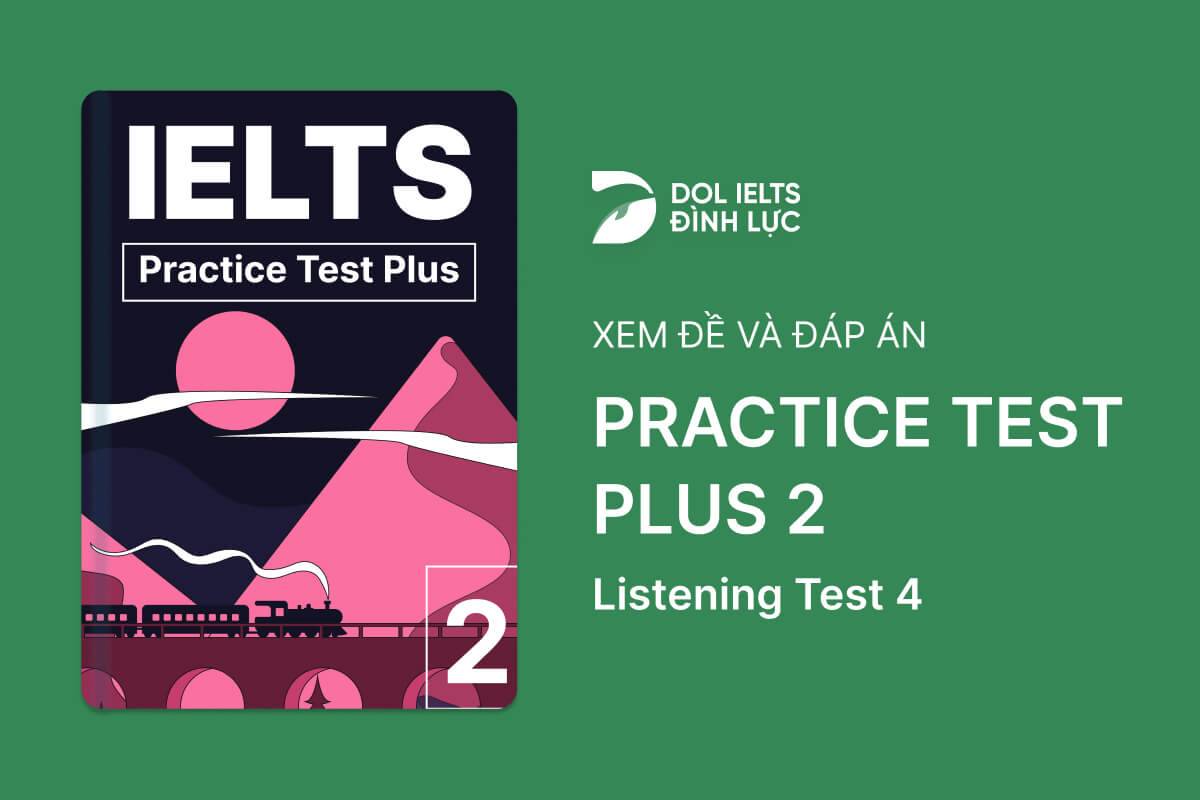Đề thi IELTS Online Test Practice Test Plus 2 - Listening Test 4 - Download PDF Câu hỏi, Transcript và Đáp án
Luyện tập đề IELTS Online Test Practice Test Plus 2 - Listening Test 4 được lấy từ cuốn sách Practice Test Plus 2 với trải nghiệm thi IELTS trên máy và giải thích đáp án chi tiết bằng Linearthinking, kèm answer key và list từ vựng IELTS cần học trong bài đọc.
Section
👂️ Bài nghe section 1
❓ Tapescript section 1
🔥 Đáp án & giải thích section 1
Giải thích chi tiết
 Đáp án cần điền là giá tiền của Bingley’s
Đáp án cần điền là giá tiền của Bingley’s
=> Đáp án sẽ tới sau "we’d better do something now" (chuyển sang nơi khác)
 Sau đó nghe tiếp được " there's one place called Bingley's that looks possible, it's 19.75 dollars a night that's US dollars,"
Sau đó nghe tiếp được " there's one place called Bingley's that looks possible, it's 19.75 dollars a night that's US dollars,"
=> Giá của Bingley's là 19.75 đô 1 đêm
=> Đáp án:19.75 
Section
👂️ Bài nghe section 2
❓ Tapescript section 2
🔥 Đáp án & giải thích section 2
Giải thích chi tiết
 Mình cần nghe xem Jack nói gì về người dân London
Mình cần nghe xem Jack nói gì về người dân London
=> Biết đáp án sắp tới khi nghe " But here in London it's completely different"
 Sau đó nghe tiếp "you're approaching the point where a whole generation of people have grown up not being allowed by their parents to cycle"
Sau đó nghe tiếp "you're approaching the point where a whole generation of people have grown up not being allowed by their parents to cycle"
=> Cả thế hệ lớn lên mà không được bố mẹ cho phép đạp xe
=> Họ không có kinh nghiệm đạp xe
=> Chọn đáp án B 
 Nhiều bạn nghe "it was considered to be getting too dangerous, " sẽ chọn C, nhưng đây là họ nghĩ nó nguy hiểm chứ không phải họ gặp nhiều nguy hiểm khi đạp xe
Nhiều bạn nghe "it was considered to be getting too dangerous, " sẽ chọn C, nhưng đây là họ nghĩ nó nguy hiểm chứ không phải họ gặp nhiều nguy hiểm khi đạp xe
Section
👂️ Bài nghe section 3


❓ Tapescript section 3
🔥 Đáp án & giải thích section 3
Giải thích chi tiết
 Đáp án cần điền là khía cạnh mà cả hai đều đồng ý là tốt nhất
Đáp án cần điền là khía cạnh mà cả hai đều đồng ý là tốt nhất
=> Đáp án sẽ tới sau "What do you think was the strongest feature of the presentation"
 Xiao Li nói "our technique was generally good like the way we designed and used the PowerPoint slides."
Xiao Li nói "our technique was generally good like the way we designed and used the PowerPoint slides."
Cuối dùng tutor nói "So you both feel happiest about that side of the presentation"
=> Cả hai đều hài lòng với phần đó (that side=Technique)
=> Đáp án: the technique/ their technique 
Section
👂️ Bài nghe section 4
have a
and clean environment.31
meet the
of all its inhabitants.32
provide easily accessible health services.
encourage ordinary people to take part in
.33
❓ Tapescript section 4
🔥 Đáp án & giải thích section 4
Giải thích chi tiết
 Đáp án cần điền là đặc điểm của environment, bên cạnh clean (have a .... and and clean environment)
Đáp án cần điền là đặc điểm của environment, bên cạnh clean (have a .... and and clean environment)
=> BIết đáp án sắp tới khi nghe 'the World Health Organisation the WHO has come up with a set of criteria for a healthy city'(nói về môi trường)
 Tiếp tục nghe " The WHO says, that amongst other things, a healthy city must provide a clean environment which is also safe...."
Tiếp tục nghe " The WHO says, that amongst other things, a healthy city must provide a clean environment which is also safe...."
=> Healthy city cần có môi trường sạch sẽ và còn phải an toàn nữa
=> Đáp án: safe 


